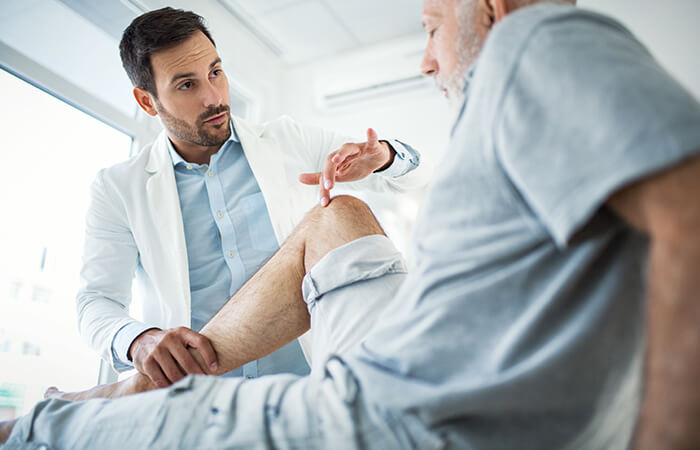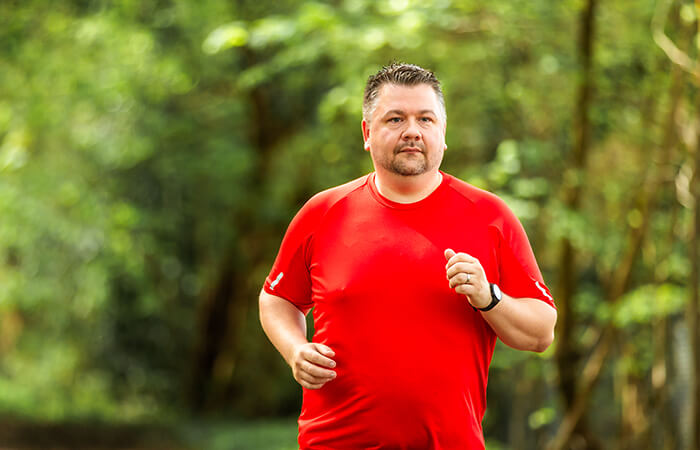Do you have shoulder pain or an orthopedic surgery coming up? You may be wondering what surgery could look like to fix your muscle, bone or joint condition.
These 3D animations shown here are just some of those used by our orthopedic specialists and can assist you in better understanding your condition or procedure. These interactive videos are meant to provide a general, educational overview and each situation is unique. We look forward to answering any additional questions you may have at your next appointment. Find a shoulder doctor to schedule an appointment if one is needed.
For a written explanation of the video or to print questions to ask your doctor, hover over the video and click on the paper or printer icons on the bottom of the video.
Bankart repair is a procedure performed to prevent repeated shoulder joint dislocations due to shoulder instability. When patients have a torn labrum, they can have repeated shoulder dislocations or lesser instability events from this tear and looseness of the shoulder tissue. Bankart repair is an effective procedure performed to restore shoulder stability.
The shoulder is a complex multi-directional ball-and-socket joint which allows movement in many directions. Shoulder instability and dislocation occur when the shoulder capsule is stretched or torn. The joint capsule surrounds the shoulder joint and is a fluid filled sac that lubricates the joint and helps to stabilize the shoulder joint by preventing excessive movement of the ball within the socket. A capsular shift procedure is performed to tighten the joint capsule.
Diagnostic shoulder arthroscopy is a procedure performed to check for disease or damage inside the shoulder joint. Problems may include arthritis, bone spurs or a torn rotator cuff. A camera attached to an instrument called an arthroscope is used to see inside the shoulder.
Distal clavicle excision is a procedure which involves the removal of the outer end of the clavicle (collarbone) to treat shoulder pain and disability. Chronic rubbing can lead to joint arthritis and inflammation which is a common shoulder problem. This causes pain, weakness and loss of motion. A distal clavicle resection treats this pain and increases strength and mobility.
A torn rotator cuff is a frequent result of injury or repetitive shoulder use. It is a common condition that can cause shoulder pain, weakness and loss of mobility. A repair procedure is done to return strength to the shoulder and improve pain.
Loose bodies are free floating pieces of debris in the joint that cause pain, swelling and locking. Loose body removal is done to remove any pieces of cartilage that are restricting movement in the joint and causing pain.
The rotator cuff is a group of muscles and tendons that keep the shoulder joint stable. Chronic rubbing can lead to a weakening and tearing of the rotator cuff, which are common shoulder problems. Symptoms of these issues include pain, weakness and loss of motion. Repairing a partially torn rotator cuff can bring strength and motion back into your shoulder while decreasing pain.
The shoulder labrum helps keep your shoulder joint in place. Shoulder instability and dislocation occur when it is stretched or torn. Repairing a detached labrum brings stability back to the shoulder area.
A reverse total shoulder replacement is performed on patients who have suffered massive rotator cuff tears, or on those patients who have undergone previously failed shoulder surgeries. The surgery removes damaged portions of the shoulder joint and replaces them with a prosthesis to improve shoulder function and decrease pain.
Shoulder instability and dislocation occur when the shoulder capsule is stretched or torn. The joint capsule surrounds the shoulder joint and is a fluid filled sac that lubricates the joint and helps to stabilize the shoulder joint by preventing excessive movement of the ball within the socket. A superior labrum anterior to posterior (SLAP) lesion repair is done to repair tears and stretches to bring strength back and decrease pain.
Chronic rubbing of bone spurring can lead to a weakening and tearing of the rotator cuff. This is also known as shoulder impingement, a common condition that causes weakness in your shoulder and pain when you raise your arm above your head. A subacromial decompression is done to make more space under your acromion, a large bony projection on the top of the shoulder blade, by removing some of the bone and tissue arthroscopically.
The synovial membrane is found in joints like your knee and shoulder and surrounds the inner lining of your joint. When part of your synovium becomes inflamed, it can often cause your entire joint to swell and become tender. A synovectomy is done to dramatically improve function and relieve pain.
Total shoulder replacement is performed when the shoulder is stiff and painful, usually caused by arthritis or degenerative joint disease. Total shoulder replacement can provide pain relief and increased range of motion and strength by replacing the humeral head with a metal ball attached to a stem that is then attached to the humerus.
The labrum is a type of cartilage found in the shoulder joint. Shoulder instability and dislocation occur when the shoulder labrum is stretched or torn. Trimming the frayed end of a torn labrum brings motion and strength back to the shoulder and relieves pain and irritation caused by the tear.
When you are injured or have muscle, bone or joint pain, it can often be confusing where to go or who to see for help. We have many convenient options to care for you and address your pain, for all ages. This guide will help you make an educated decision based on your concern, urgency, treatment needed, cost and availability. Of course, we are always just a phone call away to help guide you and schedule your appointment as needed.
As a Prevea Health patient, you are always a partner in your medical care. We strive to provide you with the knowledge needed to make educated decisions regarding your health care.
If you have any questions regarding a medical issue, please consult with your specialist at the time of your appointment or call Prevea Health at (888) 277-3832 and our staff will be happy to assist you.
These 3D animations shown here are just some of those used by our orthopedic specialists and can assist you in better understanding your condition or procedure. These interactive videos are meant to provide a general, educational overview and each situation is unique. We look forward to answering any additional questions you may have at your next appointment. Find a shoulder doctor to schedule an appointment if one is needed.
For a written explanation of the video or to print questions to ask your doctor, hover over the video and click on the paper or printer icons on the bottom of the video.
Bankart repair
Bankart repair is a procedure performed to prevent repeated shoulder joint dislocations due to shoulder instability. When patients have a torn labrum, they can have repeated shoulder dislocations or lesser instability events from this tear and looseness of the shoulder tissue. Bankart repair is an effective procedure performed to restore shoulder stability.
Capsular shift
The shoulder is a complex multi-directional ball-and-socket joint which allows movement in many directions. Shoulder instability and dislocation occur when the shoulder capsule is stretched or torn. The joint capsule surrounds the shoulder joint and is a fluid filled sac that lubricates the joint and helps to stabilize the shoulder joint by preventing excessive movement of the ball within the socket. A capsular shift procedure is performed to tighten the joint capsule.
Diagnostic shoulder arthroscopy
Diagnostic shoulder arthroscopy is a procedure performed to check for disease or damage inside the shoulder joint. Problems may include arthritis, bone spurs or a torn rotator cuff. A camera attached to an instrument called an arthroscope is used to see inside the shoulder.
Distal clavicle resection
Distal clavicle excision is a procedure which involves the removal of the outer end of the clavicle (collarbone) to treat shoulder pain and disability. Chronic rubbing can lead to joint arthritis and inflammation which is a common shoulder problem. This causes pain, weakness and loss of motion. A distal clavicle resection treats this pain and increases strength and mobility.
Fully torn rotator cuff repair
A torn rotator cuff is a frequent result of injury or repetitive shoulder use. It is a common condition that can cause shoulder pain, weakness and loss of mobility. A repair procedure is done to return strength to the shoulder and improve pain.
Loose body removal – shoulder
Loose bodies are free floating pieces of debris in the joint that cause pain, swelling and locking. Loose body removal is done to remove any pieces of cartilage that are restricting movement in the joint and causing pain.
Partially torn rotator cuff repair
The rotator cuff is a group of muscles and tendons that keep the shoulder joint stable. Chronic rubbing can lead to a weakening and tearing of the rotator cuff, which are common shoulder problems. Symptoms of these issues include pain, weakness and loss of motion. Repairing a partially torn rotator cuff can bring strength and motion back into your shoulder while decreasing pain.
Repair of detached labrum
The shoulder labrum helps keep your shoulder joint in place. Shoulder instability and dislocation occur when it is stretched or torn. Repairing a detached labrum brings stability back to the shoulder area.
Reverse total shoulder replacement
A reverse total shoulder replacement is performed on patients who have suffered massive rotator cuff tears, or on those patients who have undergone previously failed shoulder surgeries. The surgery removes damaged portions of the shoulder joint and replaces them with a prosthesis to improve shoulder function and decrease pain.
SLAP lesion repair
Shoulder instability and dislocation occur when the shoulder capsule is stretched or torn. The joint capsule surrounds the shoulder joint and is a fluid filled sac that lubricates the joint and helps to stabilize the shoulder joint by preventing excessive movement of the ball within the socket. A superior labrum anterior to posterior (SLAP) lesion repair is done to repair tears and stretches to bring strength back and decrease pain.
Subacromial decompression
Chronic rubbing of bone spurring can lead to a weakening and tearing of the rotator cuff. This is also known as shoulder impingement, a common condition that causes weakness in your shoulder and pain when you raise your arm above your head. A subacromial decompression is done to make more space under your acromion, a large bony projection on the top of the shoulder blade, by removing some of the bone and tissue arthroscopically.
Synovial problems
The synovial membrane is found in joints like your knee and shoulder and surrounds the inner lining of your joint. When part of your synovium becomes inflamed, it can often cause your entire joint to swell and become tender. A synovectomy is done to dramatically improve function and relieve pain.
Total shoulder replacement
Total shoulder replacement is performed when the shoulder is stiff and painful, usually caused by arthritis or degenerative joint disease. Total shoulder replacement can provide pain relief and increased range of motion and strength by replacing the humeral head with a metal ball attached to a stem that is then attached to the humerus.
Trimming of torn labrum
The labrum is a type of cartilage found in the shoulder joint. Shoulder instability and dislocation occur when the shoulder labrum is stretched or torn. Trimming the frayed end of a torn labrum brings motion and strength back to the shoulder and relieves pain and irritation caused by the tear.When you are injured or have muscle, bone or joint pain, it can often be confusing where to go or who to see for help. We have many convenient options to care for you and address your pain, for all ages. This guide will help you make an educated decision based on your concern, urgency, treatment needed, cost and availability. Of course, we are always just a phone call away to help guide you and schedule your appointment as needed.
As a Prevea Health patient, you are always a partner in your medical care. We strive to provide you with the knowledge needed to make educated decisions regarding your health care.
Ask the Doc interviews |
Physician articles |
What to expect |
| Watch provider videos to know how Prevea can care for your orthopedic needs. | Read articles to better understand prevention and treatment options. | Learn what to expect at your upcoming orthopedic appointment. |
| VIEW VIDEOS | READ MORE | READ MORE |
If you have any questions regarding a medical issue, please consult with your specialist at the time of your appointment or call Prevea Health at (888) 277-3832 and our staff will be happy to assist you.



